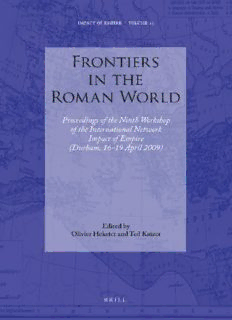
Frontiers in the Roman World: Proceedings of the Ninth Workshop of the International Network Impact of Empire (Durham, 16-19 April 2009) PDF
Preview Frontiers in the Roman World: Proceedings of the Ninth Workshop of the International Network Impact of Empire (Durham, 16-19 April 2009)
Frontiers in the Roman World Impact of Empire EditorialBoardoftheseriesImpactofEmpire (=ManagementTeamofImpactofEmpire) Lukasde Blois, Angelos Chaniotis Ségolène Demougin, Olivier Hekster, Gerda de Kleijn Luukde Ligt, Elio Lo Cascio, Michael Peachin John Rich, and Christian Witschel ExecutiveSecretariatoftheSeriesandtheNetwork Lukasde Blois, Olivier Hekster Gerda de Kleijn andJohn Rich RadboudUniversityofNijmegen,Erasmusplein1, P.O.Box9103,6500HDNijmegen,TheNetherlands AcademicBoardoftheInternationalNetworkImpactofEmpire gézaalföldy–stéphanebenoist–anthonybirley christerbruun–johndrinkwater–wernereck–peterfunke andreagiardina–johanneshahn–fikmeijer–onnovannijf marie-thérèseraepsaet-charlier–johnrichardson bertvanderspek–richardtalbert–willemzwalve VOLUME13 Frontiers in the Roman World Proceedings of the Ninth Workshop of the International Network Impact of Empire (Durham, 16–19 April 2009) Editedby Olivier Hekster and Ted Kaizer LEIDEN•BOSTON 2011 Thisbookisprintedonacid-freepaper. LibraryofCongressCataloging-in-PublicationData ImpactofEmpire(Organization).Workshop(9th:2009:Durham,England) FrontiersintheRomanworld:proceedingsoftheninthWorkshopoftheInternational NetworkImpactofEmpire(Durham,16-19April2009)/editedbyOlivierHeksterandTed Kaizer. p.cm.–(Impactofempire,ISSN1572-0500;v.13) Includesbibliographicalreferencesandindex. English,French,andGerman. ISBN978-90-04-20119-4(hardback) 1.Rome–Boundaries–History–Congresses.2.Romanprovinces–History–Congresses.I. Hekster,Olivier.II.Kaizer,TedIII.Title.IV.Series:ImpactofEmpire(RomanEmpire,c.200 B.C.-A.D.476)(Series);v.13. DG59.A2.I472011 937'.06–dc22 2011009937 ISSN 1572-0500 ISBN 9789004201194 Copyright2011byKoninklijkeBrillNV,Leiden,TheNetherlands. KoninklijkeBrillNVincorporatestheimprintsBrill,GlobalOriental,HoteiPublishing, IDCPublishers,MartinusNijhoffPublishersandVSP. Allrightsreserved.Nopartofthispublicationmaybereproduced,translated,storedin aretrievalsystem,ortransmittedinanyformorbyanymeans,electronic,mechanical, photocopying,recordingorotherwise,withoutpriorwrittenpermissionfromthepublisher. AuthorizationtophotocopyitemsforinternalorpersonaluseisgrantedbyKoninklijkeBrillNV providedthattheappropriatefeesarepaiddirectlytoTheCopyrightClearanceCenter, 222RosewoodDrive,Suite910,Danvers,MA01923,USA. Feesaresubjecttochange. CONTENTS Preface ................................................................. vii FinesProvinciae........................................................ 1 JohnRichardson TheLimitsofEmpireintheResGestaeofAmmianusMarcellinus .. 13 JanWillemDrijvers Penserlalimite:delacitéauterritoireimpérial ...................... 31 StéphaneBenoist DrawingtheLine:AnArchaeologicalMethodologyforDetecting RomanProvincialBorders.......................................... 49 KatedaCosta OntheFringe:TradeandTaxationintheEgyptianEasternDesert 61 DarioNappoandAndreaZerbini ContextualizingHadrian’sWall:TheWallas‘DebatableLands’ ..... 79 RichardHingleyandRichHartis Recherchesurlesfrontièresdel’afriqueromaine:espacesmobiles etreprésentations ................................................... 97 ArbiaHilali RomjenseitsderGrenze:KlientelkönigreicheundderImpactof Empire............................................................... 113 GüntherSchörner TheFrontiersofGraeco-RomanReligions:Greeksand Non-GreeksfromaReligiousPointofView....................... 133 ElenaMuñizGrijalvo Arxaeternaedominationis:EmperorWorshipRitualsinthe ConstructionofaRomanReligiousFrontier ...................... 149 FernandoLozano ReligiousFrontiersintheSyrian-MesopotamianDesert............. 157 LucindaDirven vi contents AFineLine?CatholicsandDonatistsinRomanNorthAfrica ...... 175 AlexanderEvers ZwischenItalienundden‚Barbaren‘:DasWerdenneuer politischerundadministrativerGrenzenin caesarisch-augusteischerZeit....................................... 199 KarlStrobel TheNewFrontiersofLateAntiquityintheNearEast.From DiocletiantoJustinian.............................................. 233 ArielS.Lewin ReducingSenatorialControloverProvincialCommanders:A ForgottenGabinianLawofbce ................................. 265 FrederikJ.Vervaet The‘UltimateFrontier’:War,TerrorandtheGreekPoleisbetween MithridatesandRome.............................................. 291 ToniÑacodelHoyo,BorjaAntela-Bernárdez, IsaíasArrayás-Morales,SalvadorBusquets-Artigas LesBatavesaucentreetàlapériphériedel’Empire:quelques hypothèsessurlesoriginesdelarévoltede–................. 305 PierreCosme ThePracticeofHospitiumontheRomanFrontier ................... 321 JohnNicols ResidentAliensandTranslocalMerchantCollegiaintheRoman Empire............................................................... 335 KoenVerboven TheImpactofWomen’sTravelsonMilitaryImageryinthe Julio-ClaudianPeriod............................................... 349 LienFoubert Index ................................................................... 363 PREFACE OlivierHekster&TedKaizer The Roman Empire, even if it purported to be imperium sine fine, cer- tainlyhadfrontiers.Bynomeansallofthem,however,wereattheouter limitsoftherealm.ThevastandheterogeneousRomanworldknewmany differenttypesoffrontiers,betweenoneprovince(orindeedonetown) andthenext,betweentheEmpireanditsso-called‘clientkingdoms’,but also at different levels within the realm. Frontiers could exist as physi- calboundaries,buttherewerealsoreligiousandcultural,administrative andeconomic,andideological frontiers.Indeed, individuals withinthe Empirecontinuouslycrossedfrontiers,switchingbetweenmultipleiden- tities such as their being Roman,inhabitant ofa town, or member of a specificpeople. The different ways in which the Roman Empire created, changed and influenced perceptions of frontiers formed the subject of the Ninth Workshopof theInternational NetworkImpact of Empire (Roman Em- pire, bc–ad), which was held at Durham University from to April.Neithertheworkshopnortheseproceedingshavetakena strictlineastohowtodefine‘frontiers’.Rather,wehopethattheassem- bledarticleswithinthisvolumeillustrateavarietyofavailableapproaches andconceptsrelatedto‘Romanfrontiers’,goingbeyondthenarrowgeo- graphicalsense. Thevolumeopenswithanintroductorysectionwithinwhichthemean- ingoftheterms‘frontier’andlimes,withinthecontextoftheempireand thecityofRome,areplacedtotheforeoveralongerperiodoftime.Thus, the paper by John Richardson (Edinburgh University) deals with the changesthattookplaceovertimeinhowfinesprovinciaewereconceived, fromtheboundariesonthepowerofRomanmagistratestoactualbor- dersofprovincialterritory,changeswhichhesuggestshavenottodowith issues of language only, but also with developments in mentality. Like- wise,throughhiscarefulanalysisoftheuseoflimesinAmmianusMar- cellinus,JanWillemDrijvers(RijksuniversiteitGroningen)distinguishes arangeof(changing)meaningsfortheword,intheprocessnotinghow viii preface Ammianusrecognisedthefrontierregionasacontactzonebetweendif- ferent cultures; a notion to which several other authors return. Finally, Stéphane Benoist (Université Charles-de-Gaulle-Lille III) reflects upon thechanging notions of the relationship between the city of Romeand herterritory,andthewayinwhichthisEmpirecouldberuled,fromthe lastcenturyoftheRepublicallthewayuntilthefifthandsixthcenturies ad.Again,changingvocabularydenotedchangingmentalities,showing developmentsinhowthetemporalandspatiallimitsofRomewereper- ceivedovertime. A second section looks at the consequences of the presence of Roman (provincial)bordersforthoselivingnearthesefrontiers.Indeed,Kateda Costa(UniversityofSydney)arguesthattracesofsuchconsequencescan be of the utmost importance in defining the spatial limits of territorial provinces.Distortions in distribution patterns of local ceramics, in her view,maywellhavebeencausedbycustomsdutyonprovincialborders, whichwouldhavemadeituneconomicaltoimportlocalceramicsfrom acrossborders.Bycarefullyanalyzingthesepatterns,then,onecanmap thelocationsofprovincialborders.Tradeanddistributionarealsocentral tothecontributionbyDarioNappo(UniversitàdiNapoliFedericoII& UniversityofOxford)andAndreaZerbini(UniversityCollegeLondon), wholookindetailathowthevariousostrakathatoverthelastfewyears havebeenfoundattheRedSeaportofBerenikecanhelpusinanalysing trade at thesouthernmostfrontieroftheEmpire. The Egyptian eastern desert,it is argued, forms a fiscalfrontier, with many repercussionsfor military,administrativeandcommercialstructuresinthearea. RichardHingley(DurhamUniversity)andRichHartis(DurhamUni- versity) look at what would have been a highly visible frontier for any- one living in its vicinity: Hadrian’s Wall. According to them, however, theWall’s monumentalsolidity notwithstanding,theareawasaporous andcontestedfrontier.Takingtheircuefromstudiesoffrontiersandbor- dersinotherculturalcontexts,theauthorspromoteabroadcomparative approachtoRomanfrontiers,andindoingsoformulatenewapproaches toRomanidentities andsocialchangeinfrontierareas.Romanfrontier zones, clearly, were not only places were Roman power was expressed through administrative (and military) supervision, but also, as is illus- trated by Arbia Hilali (Université Paris X, Nanterre), who analyses the frontiers of Roman Africa, spaces for economic exchange and social dynamics between various groups of population with divergent ways of life. Along similar lines, Günther Schörner (Friedrich-Alexander- preface ix Universität Erlangen-Nürnberg) puts forward that the so-called ‘client kingdoms’—which according to the classic formulation by D. Braund (,p.)“werethefrontiersoftheRomanempire”—illustratewell howfrontiersaretobeseeninthefirstplaceascontactzonesfordiffer- ent cultures. The adoption and adaptation of Roman cultural elements is studied throughthelens ofbuilding techniques, military equipment, crockeryandcookingmaterials,andreligiousactivity. Thislatteraspect,religiousactivity,isthesubjectofthecontributionsin thethirdsection.ElenaMuñiz Grijalvo (Universidad Pablo de Olavide, Sevilla) argues that Strabo’s Geography was intended to create a fron- tier,fromareligiousperspective,betweenthosewhoadheredtoGraeco- Romanpatternsofworshipandthosewhodidnot,andsimultaneously tonavigatetheinhabitantsoftheGreekpartofRome’sempiretothevery heartofthatsameempire.FernandoLozano(UniversidaddeSevilla)dis- cussestheroleofemperorworship,andespeciallyofsacrificetoRome’s ruler, in the creation of a religious frontier that divided Rome and its loyal supporters from hostile outsiders. The paper by Lucinda Dirven (Universiteit van Amsterdam) focuses on the ‘religious frontiers in the Syrian-Mesopotamian desert’. Her case-studies of Roman Palmyra and Parthian Hatra show how the cultic patterns of these two cities were affected not only by their own particular economic and social circum- stances,but also by their respective alliances to the superpowersofthe ancient world.Finally, in thissection,AlexanderEvers (LoyolaUniver- sity Chicago at Rome)attacks thetraditionally upheld firm boundaries between Catholics and Donatists in the African provinces of the Late Roman Empire. It is argued that thereis no goodevidence to see (asis commonly accepted) a proper divide between the two forms of Chris- tiansintermsofsocialclass,degreeofurbanization,linguisticissuesand churcharchitecture. Frontiers,ofwhatevercategory,werenotfixed.Politicalactionsoftenhad consequences for the organisation of the realm, as is demonstrated by thearticles inthefourthsectionoftheseproceedings,onshiftingfron- tiers. Karl Strobel (Universität Klagenfurt) sets out how administrative and fiscal frontiers in the alpine territory changed during the political dominance of Caesar and Augustus, and how these related to politi- cal developments in the region. Going to the other end of the chrono- logical spectrum, Ariel Lewin (Università degli studi della Basilicata, Sede di Potenza) supplies an overviewofthechangesalong theeastern
Description: